How a Customer Self-Service Portal Improves Customer Experience
It’s hard to believe now, but providing better customer service was once just another business cliche.
While the merit of some cliches, such as “outside-the-box thinking,” may be debatable, companies today realize the value of serving customers well. And we know more about their service preferences than ever before, thanks to an abundance of consumer data.
This data shows one type of service towering above the rest: customer self-service.
To learn more, we spoke with software vendors that help companies provide this service, and one company that’s putting customer service software into action to highlight the top three benefits of customer self-service portals.
But first, we looked at insights from consumers themselves…
Consumers Prefer Self-Service, But Have Very Limited Patience
When a consumer has a question about a company’s products or services, where’s the first place they look for an answer? The Internet.
Echoing what we’ve found in similar studies, our most recent consumer survey shows that almost three-quarters of respondents start by looking for answers online themselves.
What Consumers Do First When They Have Questions for a Company
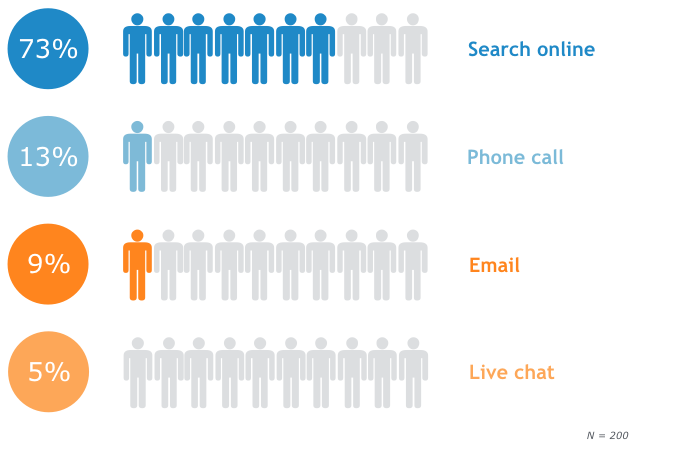
Searching for their answer online is, by definition, an attempt at customer self-service. Whether or not it’s a successful attempt depends on two things:
How long the customer is willing to search
How easy the company’s self-service portal makes it to find that information
As it turns out, most customers aren’t willing to search very long before giving up and contacting the company directly:
Time Spent Searching for Answer Online Before Contacting Company
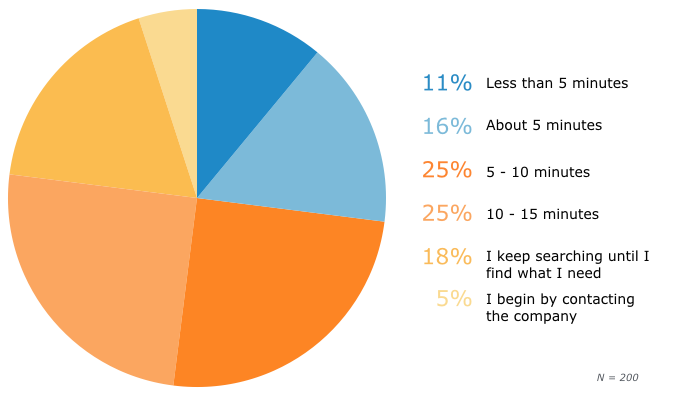
Clearly, it’s important for companies to make self-service information available online. It’s also clear that customers need to be able to find it in a matter of minutes.
Now, let’s take a look at the top three benefits a customer self-service portal can yield.
1. Self-Service Portals Provide Around-the-Clock Assistance
Founded in 1986, NICE Systems provides software solutions to thousands of companies, including 85 percent of those on the Fortune 100. Their clients use these solutions to improve their self-service portals and other online resources.
NICE’s long history provides a unique perspective on the issue of using software to improve the customer experience.
Matthew Storm, head of North American marketing for NICE Systems, says he’s noticed a “significant shift” in the motivations of companies that contact NICE for help researching self-service options.
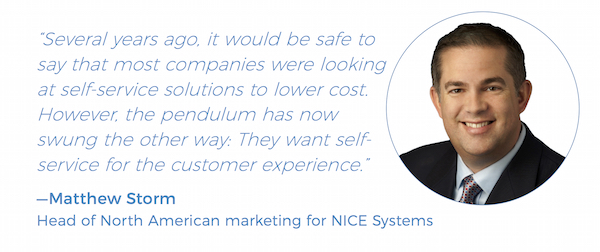
The driver for this, Storm explains, is that customers now want “service on their terms—around the clock and with the least amount of friction.”
Not only do customers want this, many of them have come to expect it. Whenever a particular company doesn’t meet these expectations, customers are tempted to switch allegiance to one that does.
Importantly, Storm says this emphasis on customer experience is here to stay.
“We do not expect the pendulum to swing back,” Storm continues. “Millennials prefer quick, technology-based resolution rather than the human interaction that was a hallmark of excellent service to their parents.”
This is good news for all involved. Self-service portals offer the exact type of service a majority of consumers prefer. These portals can be quickly and easily accessed at all hours of the day, regardless of whether the company’s call centers are open. And they often end up decreasing the company’s costs—even if that wasn’t the primary motivation.
2. Knowledge Management Software = Easy to Find Answers
Voices.com is an online marketplace for voice talent. Not only is it a successful business, it has also experienced success with its customer self-service portal.
We spoke with co-founder Stephanie Ciccarelli to understand how the company’s self-service strategy developed over time. It’s a great example for other businesses to follow.
“In the beginning,” Ciccarelli explains, “We did a lot of our customer service through email and MSN Messenger, copying and pasting common responses into our email replies while personalizing the details for each recipient.”
This is how many companies start out. Lacking dedicated customer service software, all incoming questions are responded to manually using non-specialized software. This method can work temporarily, but it’s far from efficient.
Many of the companies that contact Software Advice for help choosing new software are in the process of realizing this. They’ve gotten by so far with manual responses, but have reached a point where the inefficiency is no longer tenable.
Does your company’s service department still rely on manual methods? Contact our customer service Software Advisors for a free 15-minute consultation at (888) 234-5187.
Since they got many of the same questions over and over, Ciccarelli’s team realized they could proactively publish some of the answers online for customers to find on their own.
“Many of the answers we sent to people,” continues Ciccarelli, “were repurposed as content for our company blog.”
Company blogs often provide helpful customer service information, but they’re rarely the first place customers turn for an answer. Instead, most begin with a general online search, using Google, Bing or another search engine.
To cater to this preference, Voices.com knew it needed a better-organized and more easily searchable way of presenting self-service information. For this, the company decided to use the knowledge management applications in Service Cloud.
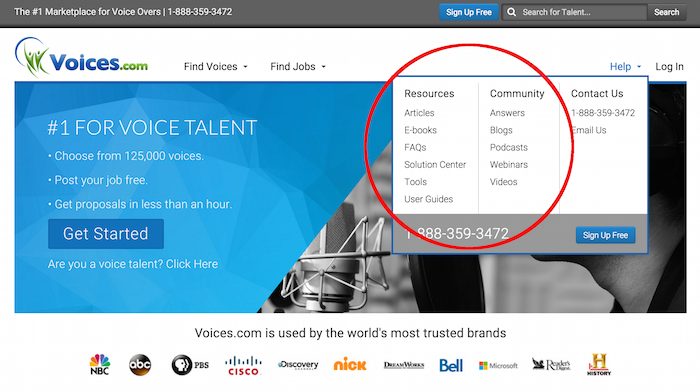
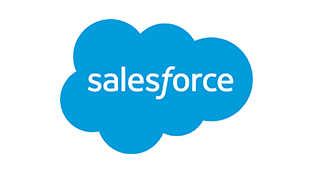
Self-service portal resources, circled in red, include a variety of content formats
Today, Voices.com’s self-service portal offers a variety of content formats and genres, including articles, e-books, user guides and FAQs.
“Not only do people want to find answers on their own,” says Ciccarelli, they want different types of answers in different formats. Presenting varied self-service content is an easy way to improve the user experience for a wider variety of customers—and it’s made possible with knowledge management (KM) software.
Knowledge management software keeps online and offline information organized. It helps users manage publishing in a variety of formats and keep track of content pieces, so they can make sure all necessary topics are covered.
KM software helps with search engine optimization (SEO), as well: For example, it ensures content can be read by search engines and helps users create clear, descriptive titles and subtitles. This makes your content easier for consumers to find quickly—improving their experience, while bringing you more search traffic.
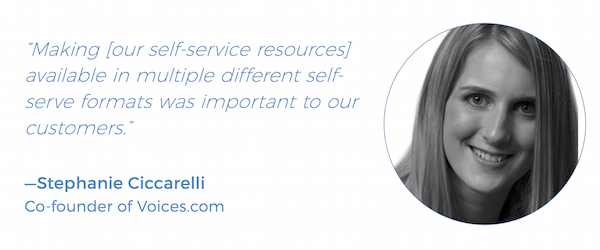
Today, the Voices.com customer service team serves over 250,000 customers. Remarkably, its response time is the same as it was back when the company had only a few hundred customers.
Voices.com’s Best Practices for Maintaining a Self-Service Portal:
The knowledge base is updated when new features are added or changed to ensure everything is up to date.
A list of the lowest-rated self-service articles is reviewed bi-weekly. Each article is gone over individually to see if there is a legitimate reason for its low rating (e.g., it’s difficult to understand), and is corrected and/or improved when necessary.
“Featured” FAQs are updated once a month to reflect the topics the company has received the greatest number of inquiries about.
3. Omnichannel Support Offers Customers Options
As we’ve shown through previous research, there are some types of inquiries—such as those about finances—that consumers may prefer to use traditional channels for. What’s more, for some on-the-go customers, accessing a self-service portal can be difficult through the smaller screen of a mobile device.
As effective as they often are, customer self-service portals can’t resolve all service requests.
“By 2017, one-third of all customer service interactions will still require the support of a human intermediary.”
—Gartner, January 2015
Omnichannel customer support systems centralize all of a customer’s prior and current interactions into one integrated interface for the support agent.
Through an omnichannel system, a customer could email a question, receive a follow-up phone call and confirm something via SMS text message—and never need to repeat themselves to a customer service agent.
Any agent who picks up the ticket will see the whole picture.
OneReach is an omnichannel customer support platform with a focus on improving user experience and customer engagement. It achieves this by integrating traditional contact channels, such as voice and email, with newer channels, such as SMS text messaging and live chat.
This integration eliminates one of the loudest and longest-standing customer complaints: The need to repeat or re-explain their problem each time they get transferred to a new agent or switch channels.
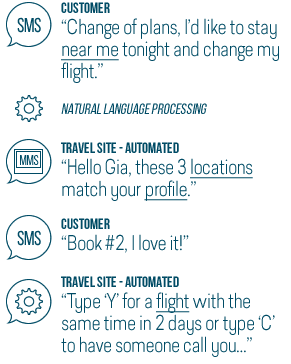
OneReach’s example dialog between a customer and an online travel-booking site, shows how an automated self-service portal can interact with customers naturally
We spoke with OneReach CEO Rich Weborg to learn more about how businesses—particularly SMBs—are learning to overcome challenges when improving the user experience of their customer service offerings.
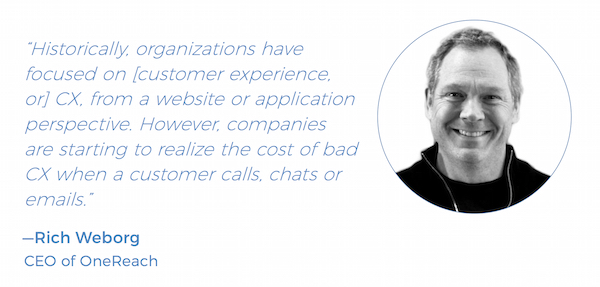
As Weborg explains, companies now define customer experience more broadly. It’s no longer good enough to offer a great CX on only a website or a mobile app. The same CX must follow the customer, regardless of which channel they use.
In the past, Weborg says, “supporting an omnichannel strategy was more difficult for SMBs because of the cost of the software and the cost to staff the channels.” But this is no longer the case, he notes.
“As SAAS communications solutions have evolved, it has become more common for a single [software] product to support voice, Web chat, text messaging, social and email,” says Weborg.
Now that omnichannel capabilities are available from the same software platforms used to manage customer service departments and self-service resources, more companies are investing in them.
Weborg offers an example of these capabilities in action: Say you have a business that sells restaurant supplies. With omnichannel support, the business lets customers either call or text to order parts and supplies, whichever they prefer. Customers can also get pictures of the products texted to them (via MMS) so they can view them before purchase. For many, this provides the ideal user and customer experience.
Conclusions
User experience is all about catering to consumer preferences. Thankfully, these preferences are something we know a lot about. Keep the following best practices in mind as you begin planning your self-service portal:
Give your customers service on their terms. For many companies, this means answers to the most common service questions should be provided where most consumers look first: the Internet. Online self-service portals provide the kind of “always-on” service many prefer.
Make online answers very easy for customers to find. Consumer patience runs thin quickly. To help visitors find answers fast, you’ll need a well-organized website that has been optimized for search engines. Self-service software with knowledge management applications can help with both.
Consider omnichannel support for customers who need more help. Though most consumers will try to answer their own questions, not all will be successful. An omnichannel customer support platform will minimize frustrations for those who need to contact your company through other channels.
If you need more help sorting through the many software options available to improve customer experiences, take a look at our e-book: Choosing Web Self-Service Software: How 3 Companies Addressed Their Service Challenges.
Explore CRM categories: